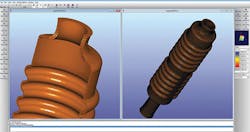Compuplast International (USA) Inc. will soon launch new versions of simulation software for blow molding, extrusion and thermoforming that are designed to reduce product development times while increasing production rates and process consistency.
The Williamsville, N.Y., company's B-SIM Version 2.6 software for blow molding will have the ability to generate a fully 3-D finite element mesh of the parison. The new capability will help to minimize discrepancies that can arise during the process of modeling a small blow molded part, VP John Perdikoulias said in an interview at Antec last month.
The new B-SIM version will debut at K 2016 in Germany, said Perdikoulias. B-SIM predicts the final part wall thickness distribution based on the specified processing parameters, such as pressure level, tool movement, and size and temperature of the preform or parison, said Perdikoulias.
B-SIM can simulate extrusion blow molding from the parison or stretch blow molding from the preform. All molds are movable in the simulation, and up to 20 independently moving molds can be used in one simulation project.
Compuplast's Virtual Extrusion Laboratory (VEL), a suite of simulation software modules that each address a particular aspect of extrusion, will be available in a new 6.9 version around the time of the K show. One advance to the software will be the full 3-D capability of its Profile Die module. "Users can analyze the profile die, incorporating 3-D effects for better process development," said Perdikoulias.
The Profile Die module can be used to optimize cross sections of any shape, such as multilumen medical tubing. The software can evaluate a number of flow characteristics, including material flow distribution through the die, pressure drop, velocity distribution and shear stress distribution. The VEL Profile Die features improvements to the graphical design, material database interface and data storage capability. The module now can simulate wall slip effects, and can be used to maximize process stability and production rate. Users can optimize an existing profile die design or create a new design using the software. The profile cooling module can be used to estimate the maximum production rate or determine the amount of cooling required for a given line speed.
VEL is composed of 12 simulation modules that address sheet extrusion, cast film, extrusion coating, blown film, profile extrusion, pipe extrusion, cable coating, extrusion blow molding and medical applications. The suite also includes a module for simulating and optimizing the extruder and simulating more generic 2-D and 3-D flow fields using finite element models.
A fully 3-D version of Compuplast's T-SIM software for thermoforming simulation is in the works, said Perdikoulias.
Mikell Knights, senior correspondent
Contact:
Compuplast International (USA) Inc., 716-536-3426, www.compuplast.com

